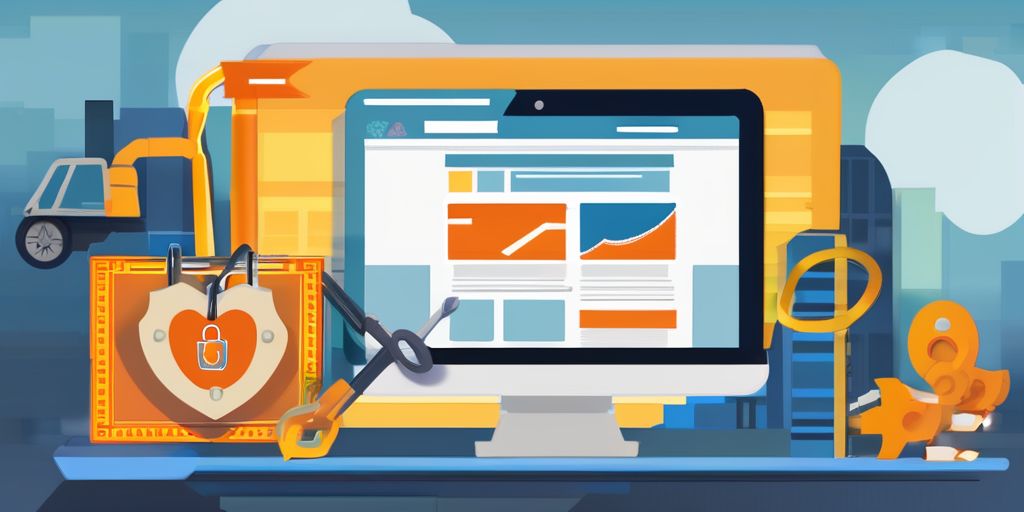Protecting your small business website is crucial in today’s digital landscape. With the increasing risk of online threats such as hacking, data theft, and security breaches, it’s essential to implement effective security measures to safeguard your website and its users. This article provides valuable insights and best practices to help you protect your small business website from potential security risks.
Key Takeaways
- Regularly update security software to protect against attacks and malware
- Implement SSL encryption to secure data transmission
- Choose a reputable web host and e-commerce platform with built-in security features
- Use role-based access control to monitor and manage user permissions
- Create a backup schedule and regularly test and restore backups
Understanding Website Security
Identifying Common Security Threats
Understanding the types of security risks that businesses face is crucial for implementing effective security measures. Businesses encounter various threats, including ransomware, phishing, data leaks, hacking, and insider threats. Phishing, for instance, is an attempt to trick users into revealing sensitive data, often through deceptive emails. It is essential to raise awareness among employees about these threats and provide regular security training to recognize and respond to them effectively.
To defend against these threats, it is important to monitor staff post-training and encourage managers to raise awareness about the signs of potential attacks. Additionally, keeping software up to date and running regular cybersecurity audits are essential practices to mitigate security risks. It is also crucial to follow best cybersecurity practices and educate the team about the common attack vectors, such as software vulnerabilities, phishing emails, and remote desktop exploitation.
Implementing Secure Authentication Methods
When implementing secure authentication methods, it is crucial to prioritize multi-factor authentication (MFA). MFA adds an extra layer of security by requiring users to provide more than one piece of evidence to verify their identity. This can include a combination of passwords, codes sent to email or phone, or biometric factors like fingerprints or face scans. Additionally, consider instituting centralized password management across your business to enhance control and security. Here are some key points to consider:
- Use MFA to prevent unauthorized access, even if passwords are compromised.
- Implement centralized password management for better control and security.
It’s important to note that user roles and permissions play a significant role in access control. Regulating user roles and permissions ensures that access is limited to authorized actions and data. By prioritizing these measures, you can significantly enhance the security of your website or e-commerce platform.
Securing Sensitive Data
Storing confidential data on your website or e-commerce platform can expose you to the risk of data breaches, identity theft, or fraud, as hackers can access or steal your data if they manage to break into your site. Therefore, you should avoid storing confidential data on your site, and instead use secure third-party services, such as payment gateways, cloud storage, or encryption tools, to handle and store your data. You should also delete any unnecessary or outdated data from your site, and use a secure web host and e-commerce platform that comply with the Payment Card Industry Data Security Standard (PCI DSS). Additionally, it’s important to note the general steps taken to keep data secured and provide opt-out procedures for unsolicited communications to comply with relevant laws.
Best Practices for Website Backup
Choosing the Right Backup Solution
A reliable backup solution is crucial for protecting your small business website from potential data loss or security breaches. When choosing the right backup solution, consider the following key factors:
- Reliability: Ensure the backup solution is reliable and has a proven track record of data protection.
- Regular Backup Schedule: Set up a regular backup schedule to ensure that your website’s data is consistently backed up.
- Secure Storage*: Store backup files in a secure location to prevent unauthorized access and ensure the integrity of the backups.
It’s important to test backups regularly to ensure they can be restored effectively. Additionally, having a disaster recovery plan in place is essential for addressing security breaches or data loss effectively. Remember, a reliable backup solution and a regular backup schedule are fundamental to safeguarding your website’s data and minimizing the impact of potential security incidents.
Creating a Backup Schedule
A reliable backup solution and a regular backup schedule are essential for protecting your website from potential data loss or security breaches. Storing backup files in a secure location and testing backups regularly are crucial steps to ensure the integrity of your backup process. Additionally, having a disaster recovery plan in place is important for mitigating the impact of security incidents or data loss.
To effectively manage your backup schedule, consider the following tips:
- Choose a reliable backup solution
- Store backup files in a secure location
- Test backups regularly to ensure they can be restored
- Have a disaster recovery plan in place for security breaches or data loss
It’s important to educate your users on the importance of online security to prevent security breaches and protect sensitive data. Providing clear guidelines on creating strong passwords and implementing multi-factor authentication can significantly enhance the security of your website.
Regularly backing up your site is crucial for protecting against hardware failure and hacking attempts. Storing backups in a secure location, such as a cloud service or remote server, can minimize the impact of security incidents and downtime. Implementing multi-factor authentication (MFA) adds an extra layer of security by requiring users to provide multiple pieces of evidence to verify their identity before accessing your website or e-commerce platform.
When creating backups, it’s important to store full-site backups in a remote location, such as a cloud service like Amazon, Dropbox, or private clouds like Stash. Depending on the frequency of website updates, consider scheduling backups either daily or in real-time using reliable and user-friendly plugins like Duplicator, UpdraftPlus, or BlogVault.
Testing and Restoring Backups
Regularly testing and restoring backups is crucial to ensure the integrity and reliability of your website’s backup system. By conducting regular tests, you can verify that the backup files are complete and functional, minimizing the risk of data loss in the event of a security breach or system failure. Additionally, it’s important to establish a backup schedule and store backup files in a secure location, such as a cloud service, an external hard drive, or a remote server. Consider implementing multi-factor authentication (MFA) to enhance the security of your backup files and prevent unauthorized access. Remember, a reliable backup solution and a well-defined disaster recovery plan are essential components of a robust website security strategy.
Effective Use of SSL Certificates
Understanding SSL/TLS Encryption
SSL/TLS encryption is a protocol which encrypts data transfer between your website and users browser. This encryption makes it harder for someone to sniff around and steal information. Once you enable SSL, your website will use HTTPS instead of HTTP, and you will also see a padlock sign next to your website address in the browser. SSL certificates were typically issued by certificate authorities, and their prices start from $80 to hundreds of dollars each year. Due to added cost, most website owners opted to keep using the insecure protocol. To fix this, a non-profit organization called Let’s Encrypt decided to offer free SSL certificates.
An SSL certificate encrypts the data that is exchanged between your website and your visitors. It ensures that the information, such as credit card details, personal information, or login credentials, is protected from hackers and identity thieves. An SSL certificate also helps you build trust with your customers, as it shows that your website is secure and authentic. You can get an SSL certificate from your web host, your e-commerce platform, or a third-party provider, such as [Let’s Encrypt] or [Comodo].
SSL certificates are important for small businesses because they help protect customer data and increase customer trust. Even if consumers aren’t aware of what an SSL is, 78% of them say they are reassured when they see the familiar padlock symbol associated with an SSL certificate in their browser.
Understanding how SSL encryption works is crucial to ensure that your website is secure and your users’ sensitive information is protected. By using SSL encryption, you can establish a secure connection between your website and its users, which encrypts all data transmitted over the internet, making it unreadable to anyone who intercepts it.
Installing and Configuring SSL Certificates
Understanding how SSL encryption works is crucial to ensure that your website is secure and your users’ sensitive information is protected. By using SSL encryption, you can establish a secure connection between your website and its users, which encrypts all data transmitted over the internet, making it unreadable to anyone who intercepts it.
- Use Strong Passwords: Using strong passwords is essential to protect sensitive information. An SSL certificate also helps build trust with your customers, as it shows that your website is secure and authentic.
- Get an SSL Certificate: You can obtain an SSL certificate from your web host, e-commerce platform, or a third-party provider such as Let’s Encrypt or Comodo.
- Install Security Plugins: Security plugins and anti-malware software are essential for protecting your website from potential threats.
Tip: Ensure that your SSL certificate is properly installed and configured to ensure smooth functionality and fast loading speed.
Renewing and Maintaining SSL Certificates
Understanding how SSL encryption works is crucial to ensure that your website is secure and your users’ sensitive information is protected. By using SSL encryption, you can establish a secure connection between your website and its users, which encrypts all data transmitted over the internet, making it unreadable to anyone who intercepts it.
- Use Strong Passwords
- Get an SSL certificate
Using strong passwords is essential to protect your website from unauthorized access. An SSL certificate encrypts the data exchanged between your website and visitors, ensuring the protection of sensitive information such as credit card details, personal information, or login credentials. It also helps build trust with your customers, demonstrating that your website is secure and authentic.
Managing User Access and Permissions
Implementing Role-Based Access Control
User roles and permissions are the levels of access and control that you assign to different users on your website or e-commerce platform. For example, you can assign an administrator role to yourself, an editor role to your content manager, and a customer role to your buyers. This allows you to manage your site efficiently and securely by limiting the actions and data that each user can perform or access.
When regulating user roles and permissions, it’s important to consider the use of secure payment gateways. Payment gateways are responsible for handling sensitive customer data, such as credit card details, bank account information, or billing addresses. By using secure payment gateways, you can ensure the protection of sensitive information and prevent unauthorized access to financial data.
Additionally, consider the use of multi-factor authentication (MFA) to enhance the security of user access. MFA requires users to provide more than one piece of evidence to verify their identity before accessing the website or e-commerce platform. This can prevent unauthorized access, even if the password is compromised, and add an extra layer of security to user authentication.
To further enhance security, it’s recommended to configure comment settings if your website allows user comments. This includes enabling moderation queue, anti-spam measures like CAPTCHA, and keyword filters to ensure that user comments are appropriate and spam-free.
Lastly, consider using a plugin or extension to create various user roles, such as admin, editor, or contributor, and assign specific permissions to each role. This allows you to effectively manage user access and restrict access to different parts of your website.
Monitoring User Activity
Logged in users can sometimes wander away from the screen, posing a security risk. Inactive sessions can be hijacked, leading to unauthorized changes. To mitigate this risk, consider implementing automatic logout functionality for idle users. For WordPress sites, the Inactive Logout plugin can be installed and configured to automatically log out users after a specified time duration. Additionally, adding security questions to the login screen can further enhance security by adding an extra layer of authentication. This can be achieved by installing the WP Security Questions plugin and configuring security questions for the WordPress login screen.
Automatic Logout Configuration
| Configuration | Description |
|---|---|
| Time Duration | Set the duration of inactivity before automatic logout |
| Logout Message | Add a custom message to be displayed upon logout |
Tip: Implementing automatic logout and security questions can significantly enhance the security of your website and protect against unauthorized access.
Revoking Access for Inactive Users
Automatically logging out idle users is an important security measure to prevent unauthorized access and protect sensitive data. Implementing an automatic logout feature can mitigate the risk of session hijacking and unauthorized changes to user accounts. To achieve this, consider installing and activating the Inactive Logout plugin for your WordPress site. Once activated, navigate to the Settings » Inactive Logout page to configure the plugin settings. Set the time duration and add a logout message, then save your settings. Additionally, consider adding security questions to the WordPress login screen to further enhance security. Finally, regulate user roles and permissions to ensure that access is restricted to necessary users and that strong passwords and multi-factor authentication are enforced.
When it comes to managing user access and permissions, it’s crucial to have a robust security solution in place. At WebsiteSecurity.net, we understand the importance of protecting your business website from unauthorized access and ensuring that the right users have the appropriate permissions. Our team of experts specializes in providing unbeatable website security solutions that include web protection, backups, monitoring, and more. With our comprehensive services, you can have peace of mind knowing that your website is secure and your data is protected. Take the first step towards a secure online presence and explore our website security solutions today!
Conclusion
In conclusion, safeguarding your small business website is essential to protect your business and customers from online threats. By implementing robust security measures, regularly updating software, and using SSL encryption, you can establish a secure online presence. Additionally, creating high-quality content, backing up data, and integrating with social media platforms can enhance your website’s visibility and reach. Remember, security is paramount in establishing trust with your customers and ensuring the authenticity of your website.







